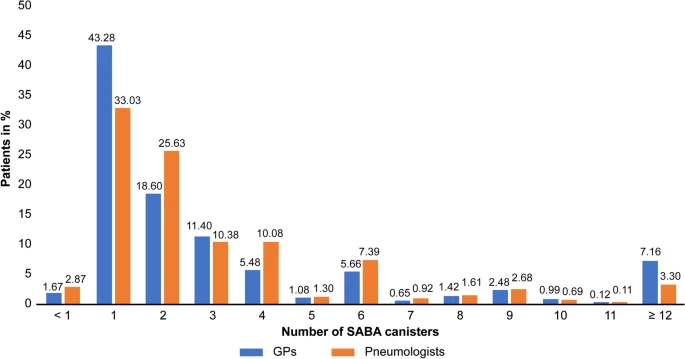Respiratory Research volume 22, Article number: 108 (2021)
Research – Open Access
Heinrich Worth, Carl-Peter Criée, Claus F. Vogelmeier, Peter Kardos, Eva-Maria Becker, Karel Kostev, Ingo Mokros & Andrea Schneider
Background
Overuse of short-acting beta-2 agonists (SABA), which do not treat the underlying inflammation of asthma, is linked to poor clinical outcomes such as increased exacerbation risk. This study, as part of the SABINA program, estimated the prevalence of SABA overuse and associated variables in outpatients in Germany.
Methods
This retrospective study used anonymized electronic healthcare data from the Disease Analyzer database (IQVIA). A total of 15,640 patients aged ≥ 12 years with asthma who received ≥ 1 SABA prescription(s) between July 2017 and June 2018 in 924 general physician and 22 pneumologist (PN) practices were included. SABA overuse was defined as ≥ 3 prescribed inhalers (~ 200 puffs each) during the study period. The associations between SABA overuse and physician specialty, Global Initiative for Asthma (GINA) steps (based on asthma medications), age, sex, and inhaled corticosteroid (ICS)/long-acting beta agonist (LABA) use were estimated using multivariable regression for patients with probable moderate (GINA step 2) and probable severe (GINA steps 3–5) asthma.
Results

Annually, 36% of all patients (GINA steps 1–5) in general and 38% in PN practices received ≥ 3 SABA inhalers. The risk of SABA overuse was 14% higher in patients treated by a general practitioner vs. a PN; 34% and 85% higher in GINA steps 4 and 5, respectively, vs. GINA step 3; and 40% higher in male vs. female patients.
Conclusions
SABA overuse is prevalent among patients with asthma across all GINA steps in Germany, which may indicate suboptimal asthma control. Further studies are needed to investigate the reasons behind SABA overuse.
